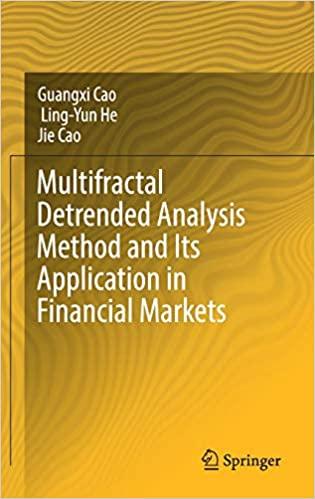
Q2. (16 marks) Consider four risky securities, such as common stocks, denoted as securities 1,2 , 3 , and 4. Let Ri be the random return of security i, for i=1,2,3, and 4 . It is known that the 22 covariance matrix of returns based on securitics 1 and 2 , denoted by V(2)=[11211222] where each matrix element ij is the covariance of returns between securities i and j, is positive definite. It is also known that R3=1R1+2R2 and R4=1R1+2R2 where 1,2,1, and 2 are non-zero constants, under the conditions of a1+2=11+2=11+2=1+2 and R1=R2=R3=R4. Denote the 33 and 44 covariance matrices of returns as V(3)=112131122232132333andV(4)=11213141122232421323334314243444. Notice that all of V(2),V(3), and V(4) are symmetric. Let x1,x2,x3, and x4 be the proportions of investment funds allocated to securities i=1,2,3, and 4, respectively. Under the condition that these proportions be all non-negative, we have xi0, for i=1,2,3, and 4, and x1+x2+x3+x4=1. There is a further condition of h1x1+h2x2+h3x3+h4x4=s, where h1,h2,h3,h4, and s are some given positive constants; this additional condition cannot be reduced to x1+x2+x3+x4=1. For a portfolio optimization problem under these conditions, it is known that the existence of a solution requires that the 66 matrix W=2112212312411h12122222322421h22132232332431h32142242342441h4111100h1h2h3h400 be invertible. Notice also that 31=Cov(R3,R1)=Cov(1R1+2R2,R1)=111+22141=Cov(R4,R1)=Cov(1R1+2R2,R1)=111+22132=Cov(R3,R2)=Cov(1R1+2R2,R2)=112+222 and 42=Cov(R4,R2)=Cov(1R1+2R2,R2)=112+222, where Cov(Ri,Rj) is the covariance of returns between securities i and j. Let 1=1122=1123=h31h12h2 and 4=h41h12h2. For the given values of 1,2,1,2,h1,h2,h3, and h4, it is known that 14=23 Use Laplace expansion repeatedly along appropriate rows or columns to express the determinant of W in terms of 1,2,3,4, and the determinant of V(2). Does the inverse of W exist? Analytical details are required. Q2. (16 marks) Consider four risky securities, such as common stocks, denoted as securities 1,2 , 3 , and 4. Let Ri be the random return of security i, for i=1,2,3, and 4 . It is known that the 22 covariance matrix of returns based on securitics 1 and 2 , denoted by V(2)=[11211222] where each matrix element ij is the covariance of returns between securities i and j, is positive definite. It is also known that R3=1R1+2R2 and R4=1R1+2R2 where 1,2,1, and 2 are non-zero constants, under the conditions of a1+2=11+2=11+2=1+2 and R1=R2=R3=R4. Denote the 33 and 44 covariance matrices of returns as V(3)=112131122232132333andV(4)=11213141122232421323334314243444. Notice that all of V(2),V(3), and V(4) are symmetric. Let x1,x2,x3, and x4 be the proportions of investment funds allocated to securities i=1,2,3, and 4, respectively. Under the condition that these proportions be all non-negative, we have xi0, for i=1,2,3, and 4, and x1+x2+x3+x4=1. There is a further condition of h1x1+h2x2+h3x3+h4x4=s, where h1,h2,h3,h4, and s are some given positive constants; this additional condition cannot be reduced to x1+x2+x3+x4=1. For a portfolio optimization problem under these conditions, it is known that the existence of a solution requires that the 66 matrix W=2112212312411h12122222322421h22132232332431h32142242342441h4111100h1h2h3h400 be invertible. Notice also that 31=Cov(R3,R1)=Cov(1R1+2R2,R1)=111+22141=Cov(R4,R1)=Cov(1R1+2R2,R1)=111+22132=Cov(R3,R2)=Cov(1R1+2R2,R2)=112+222 and 42=Cov(R4,R2)=Cov(1R1+2R2,R2)=112+222, where Cov(Ri,Rj) is the covariance of returns between securities i and j. Let 1=1122=1123=h31h12h2 and 4=h41h12h2. For the given values of 1,2,1,2,h1,h2,h3, and h4, it is known that 14=23 Use Laplace expansion repeatedly along appropriate rows or columns to express the determinant of W in terms of 1,2,3,4, and the determinant of V(2). Does the inverse of W exist? Analytical details are required







